How to Paint Stripes:
Questions and Answers
How do you paint stripes without taping the walls? What are the best tools to use for marking guide lines? Should the pattern be centered?
See the answers to these questions below and learn what to ask yourself before you start - to plan, lay out and paint stripes like a pro.
Striping paint successfully takes time and requires patience and specific know-how.
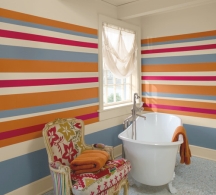
Unlike regular painting, stripes (as well as any pattern calling for a grid configuration - such as checkerboard or plaid designs) should be planned out in detail before you start.
Though this preliminary planning stage may seem tedious, time-consuming and even unnecessary, it's important that you think these patterns through to ensure that corners, obstacles and architectural elements such as doors and windows, and any oddities like sloping floors or differing wall heights are accommodated ahead of time.
NOTE: the following advice assumes you are painting stripes on walls but you can easily adapt it for striping a floor, ceiling or other surface.
Questions to Ask Yourself
Before You Paint Stripes:
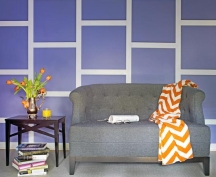
Some paint striping projects may seem overwhelming, while others look deceptively simple... only to baffle you mid-way - but these questions are a good place to start no matter the complexity of your desired pattern.
You may find that you need to change some aspect of the pattern once you complete the planning and testing stage - because oftentimes a design concept that works great in your head does not pan out quite as well in the real life application.
And that's the main value of all this preparation work - to find and avoid any potential problems before you even start.
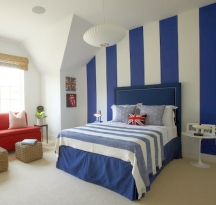
- What is the scale of the pattern? In other words, how wide is each of the stripes in the repeat?
Your choice of a striping design should be partly determined by the dimensions of the room where you will use it.
For example, big shapes will usually look great in large rooms, but will dominate small places, while pinstripe-scaled patterns will often be lost in large spaces.
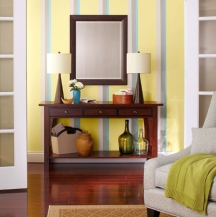
- Will your pattern be regular or irregular (that is, will it have a repeat?)
Regular vertical stripe patterns should be planned out similar to wallpaper installation when striping an entire room.
You want to make sure the design connects and continues properly once you circle the room and loop it back to the starting point. - Will the stripes have equal or varying widths?
While equal-size stripe patterns look simple, they may take more time to tape off than some multi-size combinations that are planned right.
That's why it's important to test different work sequences on paper before picking up a brush.
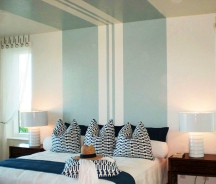
- Do you want the pattern to be centered on the wall(s)?
If so, should the center of a stripe be placed on the vertical center of the wall, or should two stripes be on the sides of the vertical center?
Either way can be fine, but depending on the scale of the pattern and the layout of the wall(s), one might be more pleasing than the other, or might work better at corners.
And of course, this will determine where you should start.
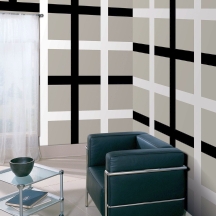
- Is the stripe pattern going on the adjacent walls?
And is it important that the pattern repeat be complete on the wall, or can it continue around the corners?
Again, there is no right or wrong here, but with some designs (like zig-zags and grids) the effects may look drastically different and you need to know in advance what to expect (especially if you are a perfectionist - you know how even a small "mistake" that only you can see can fix your attention, and kill the joy of a job otherwise beautifully done).
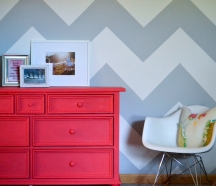
- If you are painting a Chevron or block-type pattern, will there be visible grid lines?
How wide?
Most stripe pattern combinations (both complex and simple) are often faster and easier to do with "borders", but you need to find masking tape that will match the border size you have in mind (or adapt your design expectations to whatever tape size is available to you).
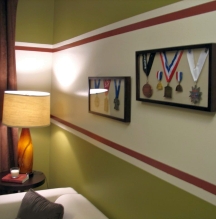
- Will the pattern cover the entire wall or only a portion of it? Then where will you stop?
You'll need to check that your furniture or wall accessories will work with the stripe placement.
Once you've answered these questions, make a scale drawing of your pattern on graph paper - it's the best way to test its proportions, placement and feasibility in the actual room setting (as well as tweak it if needed).
If everything looks great, transfer the pattern to the walls (measure, mark and tape it off) - now you know for sure that the paint stripes you envision in your head will actually look the same when painted on the walls.
Stripe Painting Q&As:
Or just explore these FAQs and specific situations submitted by other visitors - maybe you'll find an answer to yours.
How to Choose Paint Color Combinations for Wall Stripes
Question: How do you choose paint color combinations for wall stripes? What colors look good together in a stripe pattern?
Answer: Choosing a …
Should I Center Paint Stripes on the Walls?
Question: Should vertical paint stripes be centered on the walls, or should I just let them fall wherever they may? What's the right way to position …
How to Snap a Chalk Line for Painting Wall Stripes
Question: I want to paint 3 diagonal wall stripes on the accent wall in my living room, so I bought a chalk line - but I am not sure how to use it. …
Fast, Easy, No-Taping Technique for Striping Paint on the Walls
Question: I am tempted to paint stripes on my bedroom walls, but I shudder when I think of all the taping I'll have to do! Is there an easier way to …
How to Make a Plumb Bob Line for Painting Wall Stripes
Question: I'm in the middle of my first wall striping project. I've determined the size of the stripes, marked their locations across the top of the …
Painting Tone On Tone Wall Stripes: Glossy and Matte Sheen Variation
Question: I like the look of tone on tone wall stripes (where they use similar paint shades), but recently I saw a stripe pattern with alternating shiny …
How High and Wide Should the Wall Stripe Border Be?
Question: We are painting the walls in my son's room chocolate brown, with 1 orange horizontal stripe/border. My question is: how high and wide do I …
Best Tool for Painting Wall Stripes: Brush or Roller?
Question: What is the right tool for painting stripes on the walls - a brush or a roller? Everyone I ask seems to have a different opinion, and I'm confused. …
How to Measure a Pattern Repeat for Wall Stripes
Question: I want to paint wall stripes in my powder room, but I don't know how to measure the pattern's repeat, so I'm stuck in planning. Please help! …
See Also:
Decorative Paint Striping Ideas
How to Paint Stripes Without Taping
How to Paint Horizontal Wall Stripes
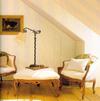



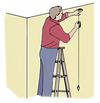


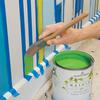










Leave a Comment: